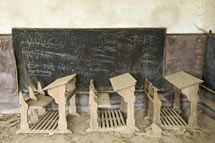
America’s schools are in such disrepair that it would cost more than $270 billion just to get elementary and secondary buildings back to their original conditions and twice that to get them up to date, a report released Tuesday estimated. In a foreword to the report, former President Bill Clinton said “we are still struggling to provide equal opportunity” to children and urged the first federal study of school buildings in almost two decades.
Clinton and the Center for Green Schools urged a Government Accountability Office assessment on what it would take to get school buildings up to date to help students learn, keep teachers healthy and put workers back on the jobs. The last such report, issued in 1995 during the Clinton administration, estimated it would take $112 billion to bring the schools into good repair and did not include the need for new buildings to accommodate the growing number of students.
The Center for Green Schools’ researchers reviewed spending and estimates schools spent $211 billion on upkeep between 1995 and 2008. During that same time, schools should have spent some $482 billion, the group calculated based on a formula included in the most recent GAO study.
That left a $271 billion gap between what should have been spent on upkeep and what was, the group reported. Each student’s share? Some $5,450.
To update and modernize the buildings, the figure doubles, to $542 billion over the next decade.
“We have a moral obligation,” said Rachel Gutter, director of the group affiliated with the U.S. Green Building Council. “When we talk about a quality education, we talk about the “who” and the “what” — teachers and curriculum — but we don’t talk about the “where.” That needs to change.”
Her organization is urging the Education Department to collect annual data on school buildings’ sizes and ages, as well as property holdings. The group also wants the Education Department’s statistics branch to keep tabs on utility and maintenance bills.
“It’s a secret that we’re keeping because it’s shameful and embarrassing to us as a country,” Gutter said.
Horror stories abound about schools with roofs that leak, plumbing that backs up and windows that do little to stop winds.
“Would you send your kids or grandkids to one of these schools?” asked National Education Association President Dennis Van Roekel, who supported the report along with the 21st Century School Fund, the American Federation of Teachers, the American Lung Association and the National PTA.
Schools’ appearances alone, of course, do not guarantee students’ success but it is certainly more difficult to teach and learn when water is coming in through the ceiling, pipes are growling or rooms are frigid.
(Next page: Green schools and poverty)
The report does not assign blame for schools’ disrepair but the problems often start at the local and state levels. In most cases, schools are funded by local property taxes and they are reliant on their neighbors’ wealth and willingness to fund their schools. A National Center for Education Statistics found large disparities between schools in areas of high poverty and those in more affluent areas.
The green schools’ report — and price tag — takes those into account but also expands the definition to include energy-efficient heating and cooling systems, sufficient electrical outlets in classrooms and enough energy to power equipment such as computers.
“As sad as it sounds, that’s a realistic number,” said Barbara Worth, director of strategic and private development at the Council of Educational Facility Planners International. “Most of the buildings in this country are over 50 years old and they were not built to last.”
National surveys of school facilities have been few and far between.
The last GAO report came in 1995 and the one before that was in 1965, Clinton wrote in his introductory letter to the report. The report that came on his watch indicated 15,000 schools were circulating air deemed unfit to breathe.
“Nothing was done since then, obviously,” said Worth, with the trade group that represents school facility planners. “They are in deplorable shape, they’re unhealthy.”
Clinton said the time has passed for action.
“Nearly 20 years later, in a country where public education is meant to serve as the great equalizer for all of its children, we are still struggling to provide equal opportunity when it comes to the upkeep, maintenance and modernization of our schools and classrooms,” Clinton wrote in his introduction to the report.
“Every day we let pass without addressing inefficient energy practices, poor indoor air quality and other problems associated with unhealthy learning environments, we are passing up tremendous opportunities. … I’m optimistic that by working together, we can give our children the best possible education and make America the world’s greatest innovator for generations to come,” Clinton wrote.
- ‘Buyer’s remorse’ dogging Common Core rollout - October 30, 2014
- Calif. law targets social media monitoring of students - October 2, 2014
- Elementary world language instruction - September 25, 2014


Comments are closed.